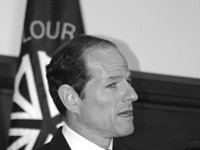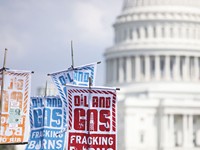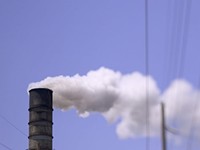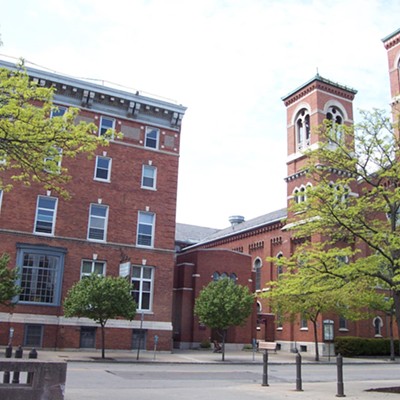[
{
"name": "500x250 Ad",
"insertPoint": "5",
"component": "15667920",
"parentWrapperClass": "",
"requiredCountToDisplay": "1"
}
]
Talk about pressure.
Less than a week after he was tapped by President Bush to head the Environmental Protection Agency, the administration's faltering clean-air policy forced Acting EPA Administrator Steve Johnson into the spotlight.
On March 9, the president's Clear Skies legislation stalled in the Senate Environment and Public Works committee. Time for plan B.
The next day, the EPA announced its Clean Air Interstate Rules, which cut emissions in 28 eastern states and the District of Columbia. Discharge levels similar to those that would have been enacted legislatively through Clear Skies will instead take effect as regulations.
Yet despite some overlap between the bill --- which environmentalists fought --- and the rules, many environmentalists are hailing the latter as progress. The Adirondack Council (which championed Clear Skies for a time, much to the consternation of fellow environmental groups) labeled the new EPA rules "the largest reduction in power plant emissions in American history."
Many environmentalists objected to Clear Skies, since it would have made it harder for a state to take legal action against power plants in another state. It also failed to address carbon dioxide emissions, a leading cause of global warming. And many environmentalists considered it too lenient on mercury. Those sticking points didn't find their way into the rules, and for now a delicate détente prevails between the administration and environmentalists.
Here's how the new rules work: The EPA sets state-by-state limits for two key pollutants: nitrogen oxides (NOx) and sulfur dioxides (SO2). (Monroe, Ontario, Orleans, Wayne, Genesee and Livingston Counties all exceed healthy standards of ground level ozone, which NOx helps form.) Then each state meets those limits any way it sees fit.
The new rules strongly encourage a "cap-and-trade" system. Under such a system, a cleaner plant releasing fewer pollutants than its allotted amount can sell the right to discharge those extra pollutants to dirtier plants. Individual plants might release more or less of the unwanted pollutants, but the overall levels drop.
"The CAIR rule doesn't require cap and trade," says EPA spokesperson Mary Mears. "It sets caps and it allows for trading, but states don't have to buy into that. Each state will decide whether it wants to participate in the program or whether it wants to simply go to its power plants and say you're cutting your emissions by X and that's what we need to do to meet the cap. New York can do whatever it wants to do, as long as its emissions do not exceed that."
But Mears predicts states will enter the informal program. "As a practical matter, states --- including New York State --- have supported trading programs in the past," she says, "and we would certainly expect that they would opt to join, because that gives the facilities in their state more flexibility. If you don't join the federal program, then the facilities inside, say, New York State can't trade with Ohio plants or what have you."
"And it is more likely," says Mears, "that the plants, by the way, in the Northeast are going to tend to be the plants that already have the controls or are closer to having the right controls and will tend to have the allocations to sell. So of course it benefits them to be able to sell those allocations."
It also benefits companies that own multiple power plants in several states. That's because plants owned by the same corporation can trade with each other, reducing the number of costly smokestack modifications the company needs to make.
But Mears says the EPA is looking at the total emissions picture.
"The states and EPA don't really care so much how the trading is done. What we care [about] is at the end of the day have you paid the piper," she says. "Is the state meeting that emission level?"
The rules have earned tepid approval from both ideological sides of the debate. While the Bush Administration offered muted approval of the rules, the president continues to call for Clear Skies' legislative changes.
On the opposite side, statewide environmental groups expressed lukewarm optimism. With the caveat that they hadn't finished reviewing the rules' final language, Environmental Advocates of New York's Christine Vanderlan offered this assessment:
"The level of reductions isn't quite as soon or as steep as we would have liked to see happen, but it's not nearly like the Clear Skies legislation, which had a mountain of rollbacks in it for the current Clean Air Act."
Vanderlan joined representatives from NYPIRG and the Adirondack Mountain Club in a press release calling the rules "a mixed bag" for New York's air quality. She and other environmental groups complain that the Clean Air Act requires the EPA to enforce each plant individually, not issue blanket reductions in state emission levels.
"That's the whole conundrum that kept it from being enforced," says the Adirondack Council's John Sheehan. "That's what caused the federal government to essentially give up on enforcing New Source Review." (Existing power plants were grandfathered into the Clean Air Act; New Source Review is a provision in the act requiring those plants to add cleaning equipment when renovating.) When the EPA tried to enforce NSR, the power companies usually managed to get the actions tied up in endless legal battles, says Sheehan.
"We don't have enough lawyers and EPA enforcement officials to go after every smokestack," he says. "This seems to guarantee that the Clean Air Act will be carried out."
Here's why he believes that: The going rate to buy the right to emit a ton of sulfur dioxide during a year is about $680 dollars. By contrast, power plants grandfathered under the Clean Air Act can add the technology to cut SO2 for $300 to $400 a ton. That means that cap-and-trade provides the right incentive to get the dirtiest plants to clean up, says Sheehan.
"In terms of the fastest and deepest cuts, that's the way to achieve them," he says.
For more information, including figures for New York, visit www.epa.gov/cair/.
Speaking of...
Latest in News
More by Krestia DeGeorge
-

The last wild Finger Lakes
Jan 17, 2007 -

Designers get their turn at downtown
Jan 17, 2007 -

From the new governor: fighting words
Jan 10, 2007 - More »

![[UPDATED] Shale drilling moratorium on today's Assembly agenda](https://media1.roccitymag.com/rochester/imager/updated-shale-drilling-moratorium-on-todays-assembly-agenda/u/review/2197062/1362582507-fracking-capital-illo_square.jpg)






